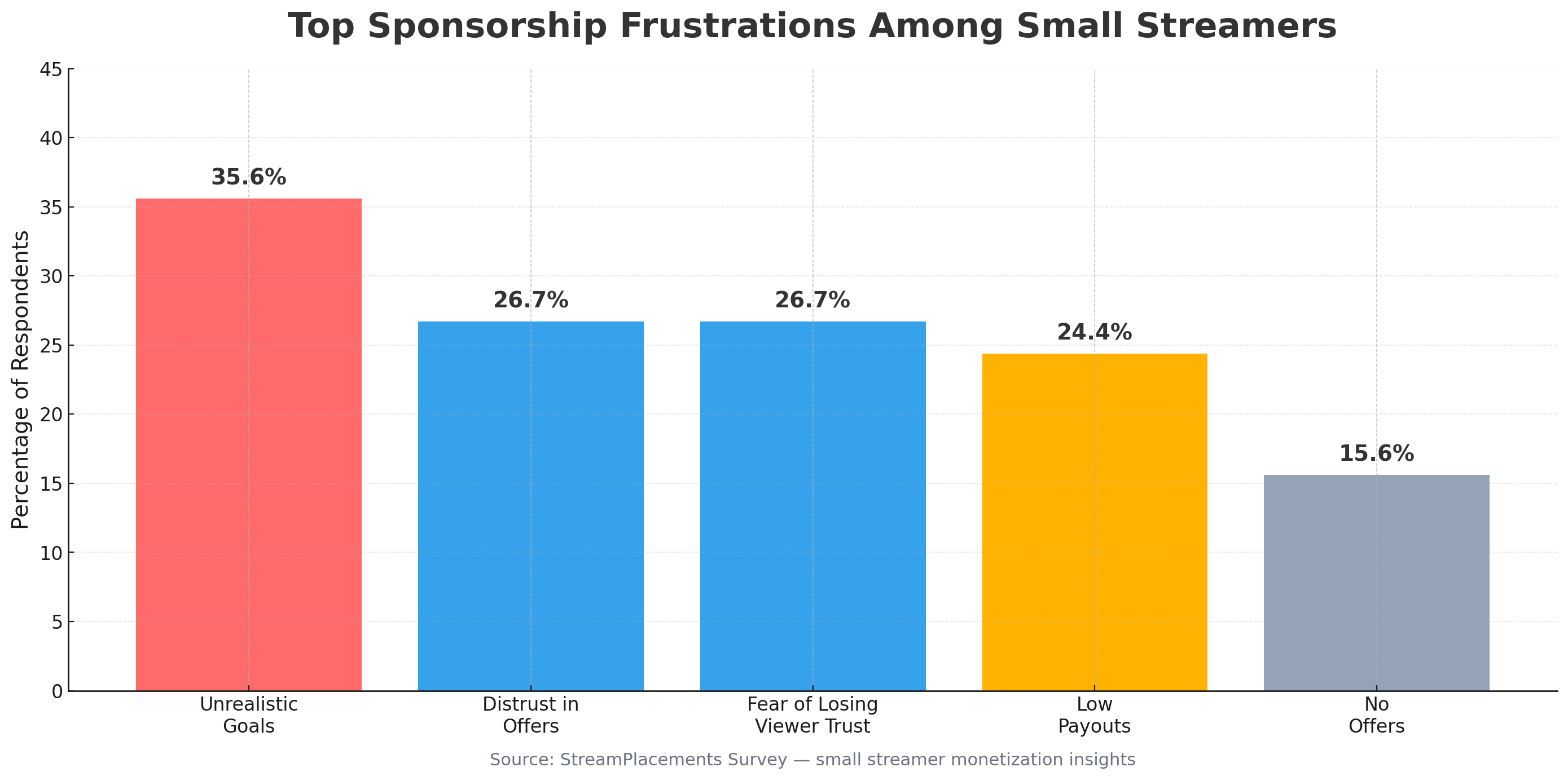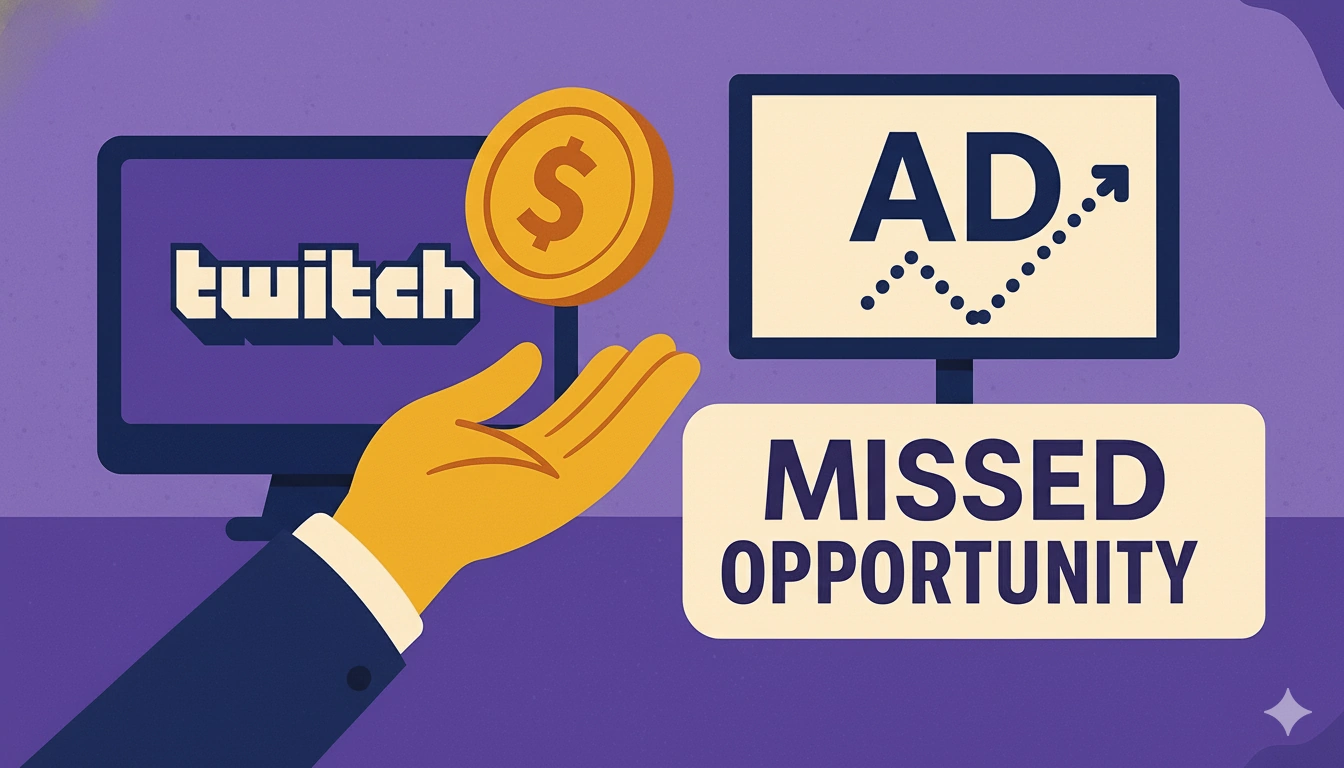Missed Opportunities in Twitch Advertising: Why Traditional Ad Clips and Misaligned Influencer Campaigns Fall Short
Brands are investing heavily in Twitch advertising and influencer sponsorships, yet many campaigns fail to reach their full potential. Viewers skip ads, streamers decline offers, and performance often undershoots expectations — not because live-stream advertising doesn’t work, but because advertisers frequently rely on outdated models designed for passive platforms, not interactive communities.
Drawing on data from a recent survey on small streamer sponsorship attitudes and a comparison of StreamPlacements banner advertising vs. traditional Twitch ads , this analysis reveals where sponsors miss value — and how more creator-aligned models close the gap.
October 2025 · Live-Stream Advertising Research · 14 min read
Traditional On-Platform Ad Clips: Familiar Scale, Hidden Waste
When advertisers think of Twitch, the first instinct is often pre-rolls and mid-rolls. These formats generate millions of impressions — at least on paper. In practice, the opportunity for impact is frequently lost:
- Viewers mute, tab out, or skip when possible
- Ad-blockers reduce reach dramatically
- Minimal audience context leads to weak brand recall
- No guarantee that the ad is even visible during watch time
According to the comparison of traditional Twitch advertising vs. integrated stream banners , these formats often suffer from exposure waste — advertisers pay for impressions that do not translate into actual attention.
Missed Opportunity #1: Context = Credibility
Viewers on Twitch are deeply immersed in live content and trust the streamer far more than the platform itself. A generic pre-roll is essentially a cold outreach attempt: irrelevant to the context and disconnected from the community culture.
Research on audience trust and brand fit in Twitch sponsorships shows that alignment with the streamer’s persona dramatically increases brand acceptance, engagement, and likelihood of action.
Direct Influencer Sponsorships: Powerful When Used Right — But Often Misaligned
Sponsoring streamers directly should be a winning formula: authenticity, community trust, active engagement. And yet, many brands still struggle to scale impact consistently.
The Small Streamer Sponsorship Survey highlights where campaigns currently fail:
- 35.6% of streamers cite unrealistic conversion-only goals as a barrier
- 26.7% fear damaging viewer trust with misaligned sponsorships
- 24.4% feel compensation is too low to justify the work
- 15.6% have never received a single offer

Sponsors overwhelmingly focus on macro-influencers — leaving a massive, engaged, but under-activated segment of micro and mid-tier streamers untouched.
Missed Opportunity #2: Micro-Influencers Drive Higher Engagement
Smaller channels often foster tighter communities and deeper personal trust. Their audience listens — but advertisers rarely approach them. With fair and structured sponsorship formats, this tier can outperform large channels on a cost-per-engagement basis.
Missed Opportunity #3: Let Streamers Maintain Their Integrity
Streamers in the study strongly preferred unobtrusive banner formats (4.42/5 satisfaction) because they don’t interrupt content or viewer rapport. Viewers see the sponsor continuously — the streamer doesn’t have to “force” mentions.
Many campaigns fail not due to bad targeting — but because sponsors demand unnatural call-outs that erode authenticity.
StreamPlacements Banner Advertising: Always Visible, Community-Friendly, and Measurable
Banner overlays are not new — but the implementation model matters. What makes StreamPlacements different is how it aligns incentives:
- Always visible during actual watch time
- Unblockable visibility ensures what advertisers pay for is seen
- Context-aligned — the ad appears right next to the streamer
- No disruption of viewer experience
- Fair compensation for creators, no pay-to-perform pressure
The detailed comparison between StreamPlacements banners and traditional Twitch ads shows up to 90% cost savings per viewer hour.
Why This Matters for ROI
With minimal “exposure waste,” brands achieve significantly stronger outcomes for the same spend — while streamers gain a consistent revenue stream that does not jeopardize audience trust.
Comparative Analysis: Which Format Misses Which Value?
Traditional ad clips miss relevance and attention.
Misaligned influencer campaigns miss trust and community fit.
StreamPlacements banners recapture lost efficiency — without sacrificing authenticity.
| Format | Primary Strength | Primary Missed Opportunity |
|---|---|---|
| Classic Twitch ad clips | Massive reach | High skip/ignore rate, low attention |
| Direct influencer sponsorships | High trust and authenticity | Often misaligned KPIs & low compensation |
| StreamPlacements banners | Guaranteed visibility with strong brand fit | Under-utilized due to legacy spending habits |
Recommended Sponsorship Strategy for 2025+
The solution isn’t abandoning existing models — it’s restructuring them around creator contexts and viewer expectations.
- Use StreamPlacements to guarantee ongoing brand presence during watch time
- Layer on targeted influencer campaigns with realistic goals per channel size
- Reserve traditional clips for broad awareness, not engagement
In other words:
Always visible banners → build familiarity
+ Streamer activations → build credibility
+ On-platform ads → extend reach
This mix minimizes waste and maximizes authenticity — the two biggest drivers of sponsorship success.
Conclusion: Where Brands Lose Value — and How to Get It Back
Live-stream audiences are loyal, discerning, and deeply connected to their favorite creators. When advertisers rely solely on intrusive or misaligned formats, they fail to tap into what makes Twitch unique: trust-based entertainment.
Brands that rethink their strategy — emphasizing creator alignment, always-visible formats, and viewer respect — can unlock far stronger performance than legacy ad models allow. For a breakdown of the audience behavior behind this shift, explore our streaming-platform advertising research (engagement and recall analysis) .
Streamers want to work with brands. Viewers want to support creators. The opportunity is already there:
It just requires sponsors to meet audiences where they are.

